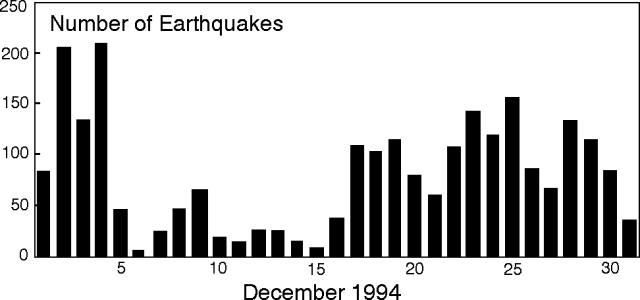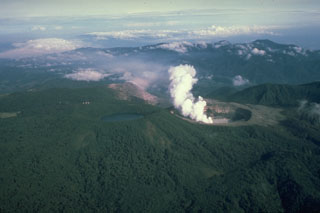Report on Poas (Costa Rica) — December 1994
Bulletin of the Global Volcanism Network, vol. 19, no. 12 (December 1994)
Managing Editor: Richard Wunderman.
Poas (Costa Rica) Seismicity low; bubbling fumaroles disappear
Please cite this report as:
Global Volcanism Program, 1994. Report on Poas (Costa Rica) (Wunderman, R., ed.). Bulletin of the Global Volcanism Network, 19:12. Smithsonian Institution. https://doi.org/10.5479/si.GVP.BGVN199412-345040
Poas
Costa Rica
10.2°N, 84.233°W; summit elev. 2697 m
All times are local (unless otherwise noted)
OVSICORI reported that during December the re-established lake in the active crater remained turquoise-green in color, had a temperature of 40°C, and had risen 2 m with respect to its level in October.
In December, the bubbling gases previously emitted from the NW part of the lake ceased. Evaporating gases rose about 50 m above the lake surface; in addition, some gases emanated from the dome.
During December, the Poás seismometer (2.7 km SW of the active crater) registered the following number of events: low frequency (< 2 Hz), 2,539; medium frequency (2.1-3.0 Hz), 14; and high frequency (> 3 Hz), 2. Low-frequency seismicity for December appears in figure 56. With respect to the previous two months, December seismicity dropped in the low- to mid-ranges, but it remained about the same for the high-frequency events. With respect to all months during the year (1994), December seismicity in all three frequency ranges was near the minimum (see table 6).
 |
Figure 56. Poás low-frequency seismicity for December 1994 (from station POA2). Courtesy of OVSICORI-UNA. |
Geological Summary. The broad vegetated edifice of Poás, one of the most active volcanoes of Costa Rica, contains three craters along a N-S line. The frequently visited multi-hued summit crater lakes of the basaltic-to-dacitic volcano are easily accessible by vehicle from the nearby capital city of San José. A N-S-trending fissure cutting the complex stratovolcano extends to the lower N flank, where it has produced the Congo stratovolcano and several lake-filled maars. The southernmost of the two summit crater lakes, Botos, last erupted about 7,500 years ago. The more prominent geothermally heated northern lake, Laguna Caliente, is one of the world's most acidic natural lakes, with a pH of near zero. It has been the site of frequent phreatic and phreatomagmatic eruptions since an eruption was reported in 1828. Eruptions often include geyser-like ejections of crater-lake water.
Information Contacts: E. Fernández, J. Barquero, R. Van der Laat, F. de Obaldia, T. Marino, V. Barboza, and R. Sáenz, OVSICORI.

